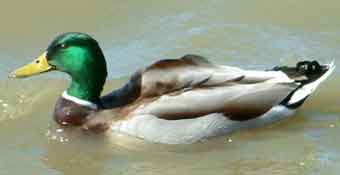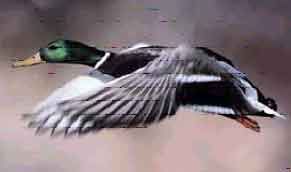Mallard
Duck
Anas platyrnchos.
Mallard ducks are the most familiar of all ducks. They are the ancestor of the
domestic duck.
Physical Description
The male is called a Drake. Its body is black, grey and white. The Mallard's
rump is black and the tail feathers are white. It has grey, white and black
wings, and has bars of green on them.
The female ducks are called hens. The females have light darker brown
patches on some feathers.
The drakes moult and take on the same coloration as the hens.
The Mallard duck chicks are white.
Mallards are about 50 - 60cm in length and have a wing span of 81 - 95cm.
Habitat
Mallard ducks are very common over Europe. They are also found in parts
of Asia, Africa and America. Mallards that live in the North and East migrate
in winter.
They inhabit parks, canals, rivers, ponds, lakes woodland and gardens. Mallard
ducks build their nests on land and line them with feathers.
Mallard ducks which are
found in parks and villages are semi-domesticated, partly due to the fact that
visitors to parks like to feed the ducks bread.

Call
Mallard ducks make the familiar 'quack' noise. The drake's call is louder
and higher pitched than the females.
Nesting
Laying eggs in March, they lay 9-13 eggs. They hatch in 27 days.
Look-alikes: Shell
Duck, Ruddy Duck.
Diet: They eat small
plants and animals. Mallard ducks feed in the water with their heads submerged
and their tails sticking up in the air. This is called 'dabbling'. They feed
both day and night.
Lifespan
They live about 20 years in captivity.
Mallards have a record of being the most abundant duck in the world.

